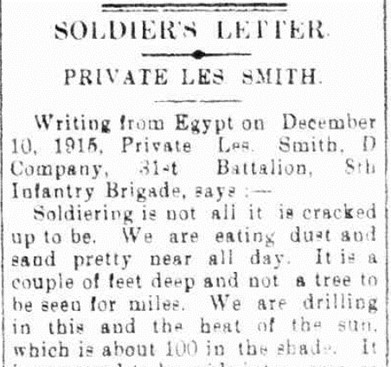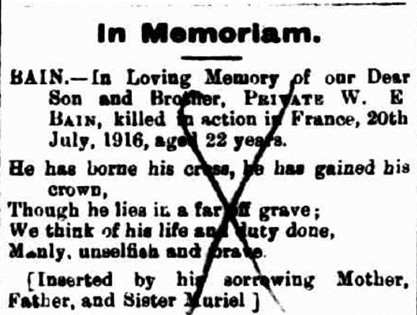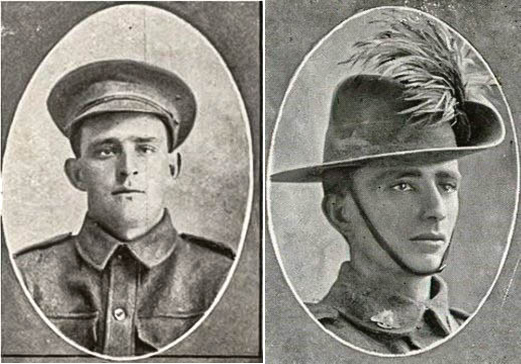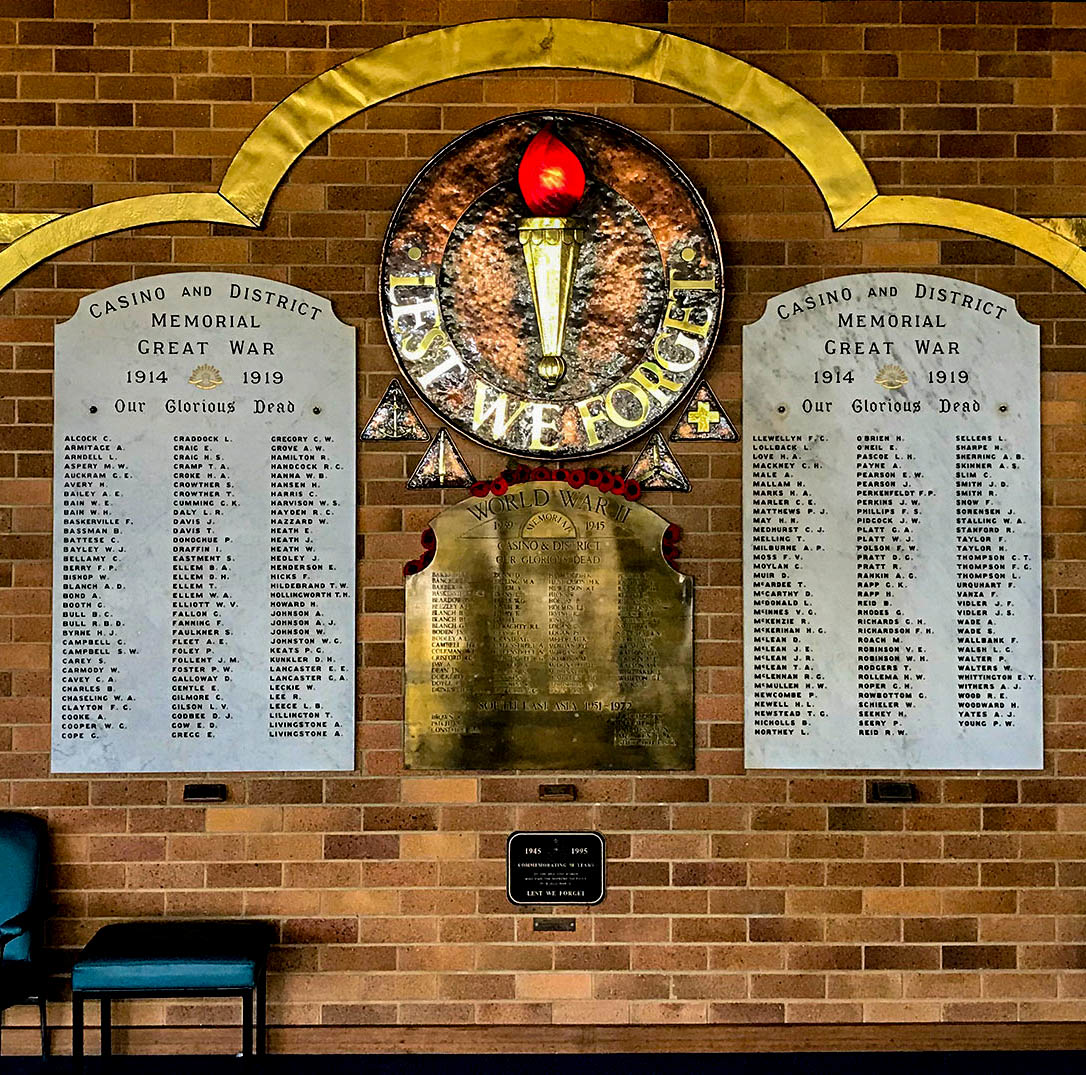
Walter Ernest BAIN
Eyes brown, Hair black, Complexion fresh
Walter Bain and His Brothers - Three Go to War, One Comes Home
We thank Tony McGuire for his contribution to the story.
Early Life
The Bains have been in Australia for a long time. Walter’s grandfather, William Gibson Bain, came to Australia from Aberdeenshire, Scotland when he was just young. His grandmother, Ellen McSweeney, came from Killarney, County Kerry, Ireland.
Their eldest son, William Gibson Bain junior, married Mary Anne Morris at Spring Creek, Killarney, Queensland on 21 August 1890. They had six children, four boys – Andrew (Andy), William (Bill), Walter (Wally) and James - and two girls – Eadith and Florence Annie (Muriel). All but Andy were born in Casino, NSW. Wally was born in August 1893.
The children attended the Casino Public school. After his schooling, Wally worked as a ‘timber getter’ - lumberjacks that went into a new area, ahead of the full operating crews.
Nine months before enlisting, he had a serious accident while he was working at Old Koreelah. He was riding home down the mountain side when his bridle rein broke, the horse bolted and Wally was thrown heavily against a tree which fractured his left thigh. Being alone in a remote area, he had to lay on the ground for several hours before being discovered and, not unexpectedly, medical help was still far away. Thirteen men worked in relays to stretcher Wally out for 9 miles to where he could be taken care of.
Source: Local and General. (1914, September 3). The Tenterfield Courier and District Advocate (NSW 1914), p. 2. http://nla.gov.au/nla.news-article135793675 .
He must have been well treated as there is no record of the injury in his Army medical files…a lucky outcome.
The Bain Boys Enlist
The call to support the War was strong in the Bain family – all four boys served. Andy, a horse breaker, was the first to enlist, 2 March 1915 at Lismore NSW, at age 24. He fought at Gallipoli and Pozieres with the 25th Battalion, C Company and then across the Western Front with the 7th Machine Gun Company and the 2nd Machine Gun Battalion.
Bill, a stockman, was next, 16 July 1915 Brisbane, at age 22. With his horsemanship skill he served with the 11th Light Horse in Egypt and Palestine, where he was killed in action.
Wally was right behind, signing up on 17 July 1915 in Brisbane at age 21. He was assigned to the 31st Battalion, A Company and served in Egypt and France.
James was just 15 at the time, too young for WW1, but he enlisted for WW2 when he was 38. He served in the Middle East and for a short time in Borneo.
Wally’s War – Egypt and Fromelles
Wally was assigned to the newly formed 31st Battalion, A Company. The battalion was to have two companies from Queensland and two companies from Victoria. The Queenslanders’ initial training was at the Rifle Range Camp in Enoggera, outside of Brisbane. The full battalion was merged in early October at Broadmeadows in Victoria. Before sailing to Egypt from Melbourne on 9 November aboard the troopship Wandilla, the 991 soldiers of the 31st had been on parade in Melbourne in front of a good crowd. The Minister for Defence, H.F. Pearce, said:
“I do not think I have ever seen a finer body of men.”
The Wandilla docked at Port Suez exactly four weeks after leaving Melbourne. They were first sent to Serapeum to guard the Suez Canal. Near the end of February they were moved to the major camp at Tel el Kebir. The 60 km trip must have been unpleasant, as it was reported that they were moved in ‘dirty horse trucks’.
Source AWM4 23/48/7, 31st Battalion War Diaries, Feb 1916, page 5
The next move was at the end of March, back to the Suez Canal at the Ferry Post and Duntroon Camps and finally to Moascar at the end of May. The months passed in training and sightseeing, but by the time the 31st Battalion was transferred to France, the men were all heartily sick of Egypt. Private Les Smith’s (934) letter home pretty well sums it up.
On 15 June, the 31st Battalion began to make their way to the Western Front, first by train from Moascar to Alexandria and then aboard the troopship Hororata, sailing to Marseilles. They disembarked on 23 June, boarded trains to Steenbeque, then marched to the camp at Morbecque, 35 km from Fleurbaix, arriving on 26 June. The battalion strength was 1019 soldiers. Training continued, now with how to handle poisonous gas included in their regimen.
They began their move towards Fleurbaix on 8 July and by 11 July they were into the trenches for the first time, in relief of the 15th Battalion.
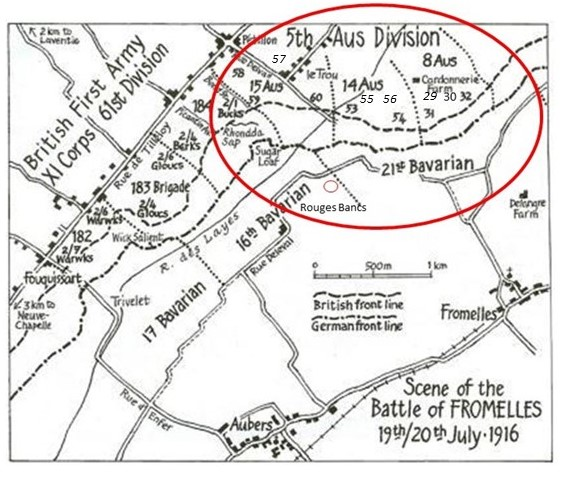
The original attack was planned for the 17th, but bad weather caused it to be postponed. On the 19th they were back into the trenches and in position at 4.00 PM.
Just prior to launching the attack, the enemy bombardment was hellish, and it seemed as if they knew accurately the time set.
The assault began at 5.58 PM and they went forward in four waves, Wally’s A Company and C Company were in the first two waves and B and D Companies in the 3rd and 4th waves. The pre battle bombardment did have a big impact and by 6.30 PM the Aussies were in control of the German’s 1st line system, which was described as “practically a ditch with from 1 to 2 feet of mud and slush at the bottom”.
Source AWM4 23/49/12, 32nd Battalion War Diaries, July 1916, page 11

Unfortunately, with the success of their attack, ‘friendly’ artillery fire caused a large number of casualties. By 8.30 PM the Australians’ left flank had come under heavy bombardment with high explosives and shrapnel. Return artillery support was provided and the 32nd, who also had the job of holding the flank to the left of the 31st, were told that “the trenches were to be held at all costs”.
Source AWM4 23/49/12, 32nd Battalion War Diaries, July 1916, page 12
Fighting continued through the night. The Australians made a further charge at the main German line, but they were low on grenades, there was machine gun fire from behind from the emplacement at Delangre Farm and they were so far advanced that they were getting shelled by both sides.
At 4.00 AM the Germans began an attack from the Australian’s left flank. Given the Australian advances that had been made earlier, portions of their rear trench had been left almost empty, which then enabled the Germans to be in a position to surround the soldiers.
At 5.30 AM the Germans attacked from both flanks in force and with bombing parties. Having only a few grenades left themselves, the only resistance the 31st could offer was with rifles:
“The enemy swarmed in and the retirement across No Mans’ Land resembled a shambles, the enemy artillery and machine guns doing deadly damage.”
The 31st were out of the trenches by the end of the day on the 20th. From the 1019 soldiers who left Egypt, the initial impact was assessed as 77 soldiers were killed or died from wounds, 414 were wounded and 85 were missing. The bravery of the soldiers of the 31st was well recognised by their own Battalion commanders.

To get some perspective of the battle, when Charles Bean, Australia’s official war historian, attended the battlefield two and half years later, he observed a large amount of bones, torn uniforms and Australian kit still on the battlefield. The ultimate total was that 161 soldiers were either killed or died from wounds and of this total 82 were missing/unidentified.
Wally’s Fate – the Family Waits
Wally was killed in the battle, but there are few details of exactly what happened to him.
In mid-August, the family were advised he was wounded and that they would ‘advise promptly if anything further was received.’
Source NAA B2455, Bain, Walter Ernest – First AIF Personnel Dossiers, 1914-1920, page 33
Next was a 31 August telex, which stated that they had no further details, but ‘it may be assumed he is progressing satisfactorily’.

This was fairly positive news, but nothing further was received, so on 10 October Wally’s sister Eadith asked for more information Wally, as well as for Bill.
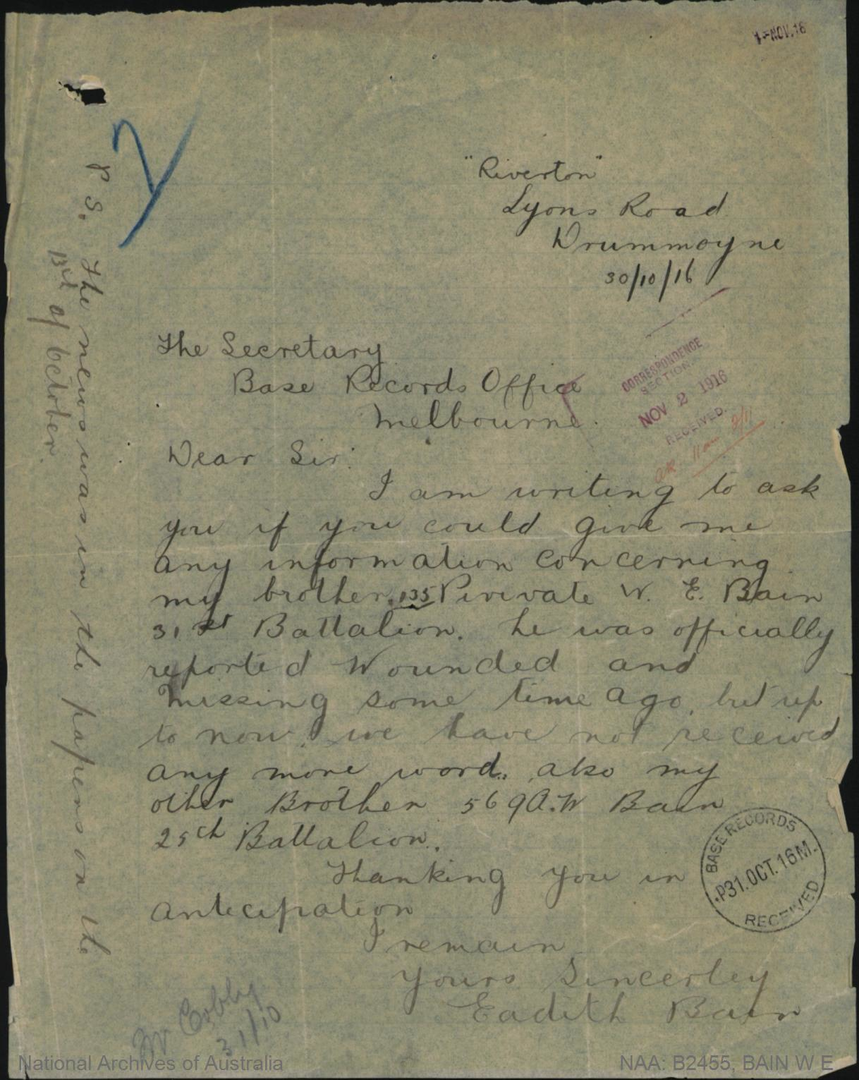
There was a prompt reply, but Wally’s status was now more serious as ‘wounded and missing’, but no further details. They also advised they had nothing to report about Bill. In January 1917 Red Cross witness statements were given by his mates in C Company who both stated that Wally was killed on the 19th and that they saw his body being buried on the 20th.
Private C. S. Jamieson (1095) reported:
”Informant states that on 20th July at Fleurbaix he saw Bain buried. Had been killed the day before”
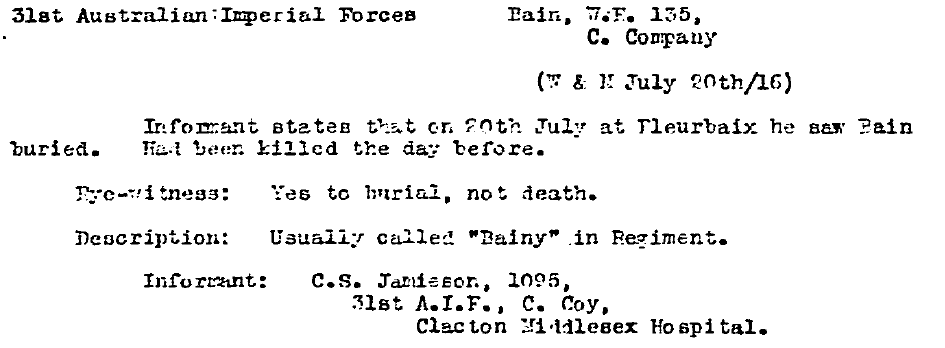
While William George Thompson’s (766) statement is less legible, but he even names the 31st’s Chaplain, Captain George Cranston, who supposedly buried Wally.

killed on 19th July (note date in the evening). I saw him
buried in the village cemetery at Fleurbaix by Chaplain
Capt. Cranston. He was thick set, dark
Informant W. Thompson 766
31st AIF
There is also a record in his files (that does appear in other’s files as well) that states “Buried” with some unknown reference numbers.
However, in February 1917 his ID tag was received from the Germans which means they would have recovered his body from the battlefield, a more likely outcome given there are no records about his burial by the Australians.
In March 1917 he was formally declared as ‘Killed in Action’.
Bill’s War – Palestine
Bill left Australia on 5 Oct 1915, headed for Egypt. His initial Light Horse Regiment duties were guarding the Suez Canal and making several forays into the Sinai Desert. In March 1916 he was reassigned to the 3rd Light Horse, but he went back to the 11th in August. Bill’s unit was moved into Palestine in April 1917 to support the advances being made there.
Their first major involvement was in the second Battle of Gaza, where they attacked, but as infantry, not mounted on their horses. The next engagement was in October 1917 at Beersheba. The 11th’s role was to protect the flanks during the battle, not as part of the main charge. They were in the main charge made at Sheria in November, where they were confronted with heavy fire, had to dismount and were eventually forced to retreat.
After Gaza fell in November, the Turkish resistance in southern Palestine collapsed and the 11th Light Horse were in the pursuit that followed. They then spent the first months of 1918 resting and training, before moving into the Jordan Valley for the raid at Es Salt, 23 km from Amman. The aim for this battle was to secure a launching point for operations against the key railway junction at Deraa.
The fighting began on 29 April and progressed well initially, with Es Salt being seized by the evening of 30 April. A determined Turkish resistance, including counterattacks that threatened the flanks and rear of the advanced elements of the raiding force, eventually forced a withdrawal back to the Jordan.
Source Australian War Memorial Collections E8424
Bill was killed on 2 May 1918 during the later stages of the battle. His body was not able to be recovered due to the circumstances around the withdrawal. Another son lost forever.

Andy’s War – Gallipoli and the Western Front
Andy left Australia at the end of June 1915, trained in Egypt during August and by early September was manning trenches in Gallipoli. Since the major offensive efforts had been completed by this time it was a relatively ‘quiet’ period. They were withdrawn from the peninsula back to Egypt in December. After being reinforced, the 25th proceeded to France in March 1916, the first AIF battalion to arrive there. Andy was in the major battle at Pozieres, 25 July - 7 August.
He was lucky enough to come out of it not being wounded, even though the 25th suffered 785 casualties. They next spent some time in a quieter sector of the front in Belgium, but did take part in two attacks to the east of Flers in November. Andy was in and out of hospital due to sickness from January through April 1917. In July 1917 he was assigned to the 7th Machine Gun Company and then to the 2nd Machine Gun Battalion in August 1918.
He fought in the major battles at Menin Road and Broodseinde in Sept-Oct 1917, the German spring offensive in northern France and in the Allied offensive of 1918, that began with the battle of Amiens in August. Andy survived all of this and he left the UK for Australia in June 1919. He was discharged in September.
Brothers Lost Forever
As discussed, Bill’s body was not recovered, while the Germans recovered Wally’s. In 2008 a mass grave dug by the Germans was found at Pheasant Wood near Fromelles. It contained 250 Australian bodies. As the 31st had been active in this area, Wally could have been in the grave.
To date (2024), 23 of the 84 unidentified soldiers from the 31st have been found to be in the grave by DNA matching from family members. Wally’s family have donated DNA, but unfortunately Wally was not able to be identified as being in the grave. He remains ‘missing’.
Wally is commemorated on Panel 3 at the V.C. Corner Australian Cemetery Memorial, Fromelles and Bill is on Panel 8 at the Jerusalem War Cemetery. Both are also commemorated at several other sites. Two brothers lost forever.
Finding Walter
DNA samples are being sought for family connections to
| Soldier | Walter Ernest Bain (1894–1916) |
| Parents | William Gibson Bain (1864–1942, Unumgar NSW – Casino NSW) and Mary Anne Morris (1872–1950, Singleton NSW – Killarney QLD) |
| Siblings | Andrew Wilson Bain (1890–1974) | ||
| William Harold Bain (1892–1918) | |||
| Edith Helen Bain (1896–1998) | |||
| Florence Annie Muriel Bain (1898–1988) | |||
| Darcy James Bain (1900–1985) |
| Grandparents | |||
| Paternal | William Gibson Bain (1840–1913) & Ellen (Helen Eileen) Sweeney/McSweeney (1842–1919) | ||
| Maternal | James Morris (1840–1904) & Ellen Susannah Smith (1851–1918) |
Seeking DNA Donors

Contacts
(Contact: carla@fromelles.info or geoffrey@fromelles.info).
(Contact: army.uwc@defence.gov.au or phone 1800 019 090).
Donations
If you are able, please contribute to the upkeep of this resource.
(Contact: bill@fromelles.info ).
